The Fascinating Partnership of Esther Williams and Dorothy Kingsley
Throughout her career, Esther Williams had her share of important collaborators. There were influential directors like Busby Berkeley and Charles Walters, as well as terrific leading men such as Van Johnson, Ricardo Montalban, and third husband Fernando Lamas. But one collaborator who doesn't get mentioned enough is screenwriter Dorothy Kingsley.
One of classic Hollywood's best musical and comedy writers, Kingsley started her career after listening to radio programs while recuperating from the measles. Believing she could write better material, she struggled to find an agent, later remarking, "It was impossible to get hired if you were a woman gag writer, as there wasn't such a thing at the time." She found her savior in Constance Bennett, who enjoyed Kingsley's work and used some of her gags on her radio program. A divorced mother of three, Kingsley was then able to support her family by writing for Edgar Bergen's popular radio show. It was during this time that she began submitting scripts to various studios until she was hired by MGM producer Arthur Freed. Her first assignment was to write additional dialogue for the Mickey Rooney-Judy Garland vehicle Girl Crazy (1943). Her next job? Polishing the script of Bathing Beauty, a musical that would star Red Skelton and a newcomer named Esther Williams.
"While I was working on Girl Crazy, I met [producer] Jack Cummings, who was having a lot of trouble with a picture called Bathing Beauty," Kingsley told author Patrick McGilligan. "I had some ideas about it, so he asked [MGM executive] Sam Katz if he could have me to work on it. There'd been a million writers on it but the script was just bleh, lying there. ... I had to think up something and then send a page down for them to shoot. It was really wild. ... I had a real baptism of fire. But the picture worked out, it was a big hit, Esther's first big picture."
This was demonstrated with Esther and Kingsley's next collaboration, Easy to Wed (1946). From the second MGM asked her to sign a contract, Esther thought the studio was crazy to want a champion swimmer for a star. Nevertheless, she wanted to justify their faith in her by doing her best to improve herself and her films, whether that meant studying acting, taking singing lessons, or suggesting line revisions. She found an ally in Kingsley. Unlike most of her films' writers, Esther observed, Kingsley would consult her before making changes and they quickly respected one another. "She had a real feeling for the needs of leading ladies," Esther said, "and she was willing to work with me to get a script we were both happy with." Together, they rewrote the confrontation scene between Esther and Lucille Ball's characters in Easy to Wed because they agreed it didn't sound like how women really talk to one another.
To Esther's appreciation, Kingsley welcomed her ideas. For the end of the English Channel race sequence in Dangerous When Wet (1953), for example, it was Esther who supplied its dramatic conclusion to Kingsley after seeing news coverage of long-distance swimmer Florence Chadwick breaking her Catalina Channel record with the help of her friend Johnny Weissmuller, who jumped into the water to pace her to the finish line. Esther was also reported to be part of the story conferences for Jupiter's Darling (1955).
In her own words, Kingsley found Esther to be "easy to deal with. But they were not soul-searching lines. She knew what she was good at." In many of the Kingsley-penned aquamusicals, you can find details that were directly inspired by Esther's own life. On an Island with You (1948) has a plot point about Esther's character visiting with WWII soldiers, which she did in 1944, and even reproduces the exact routine she did to entertain them. In Texas Carnival (1951), it is revealed that her character had been swimming in a water pageant show when she was discovered by her carnival act partner, which is similar to how MGM found her in Billy Rose's Aquacade.
Neptune's Daughter (1949) finds her playing a champion swimmer who reluctantly gives up competing for a new business venture, mirroring Esther's own hesitancy to leave competing behind for Hollywood. Around the time that the film went into production, Esther began working with swimsuit manufacturer Cole of California, so there is a possibility that her work for them was why her character Eve becomes a swimsuit designer. Esther does mention in her autobiography that she had Cole make the suits that the female swimmers are wearing in the finale, plus there are advertisements Esther made for Cole in the background of Eve's office.
Kingsley's mixing of Esther's real and reel lives helped contribute to the naturalism that permeates Esther's star image, naturalism being an acting style that closes the gap between the performer and their characters. This allowed Esther to play herself essentially, blurring the lines between performance and self. Naturalism encourages the idea of Esther and her characters being one and the same, which in turn strengthens her persona as a savvy, feminist careerwoman.
Although critics and Esther herself often bemoaned the aquamusical's predictability in terms of plot, audiences couldn't get enough. Today, Esther's films are still dismissed as fluff, with their feather-light atmosphere and improbable plots seen as invalidating rather than entertainment in its purest form.
"Swimming musicals were fun and beautiful to look at and were clearly adored by the public, but they didn't win any Academy Awards," Esther once remarked. When Patrick McGilligan asked Kingsley if they were considered "lesser vehicles" by MGM, she replied, "No. There was the musical unit and there was the serious unit, but the musicals made great money. During World War II, you had fighting all over the world and people wanted to escape from all of the problems of the day, I think. The Esther Williams pictures were never taken that seriously, but she was popular. They were intended to get Esther into the theaters, they were spectacles, and they made a lot of money."
"Swimming musicals were fun and beautiful to look at and were clearly adored by the public, but they didn't win any Academy Awards," Esther once remarked. When Patrick McGilligan asked Kingsley if they were considered "lesser vehicles" by MGM, she replied, "No. There was the musical unit and there was the serious unit, but the musicals made great money. During World War II, you had fighting all over the world and people wanted to escape from all of the problems of the day, I think. The Esther Williams pictures were never taken that seriously, but she was popular. They were intended to get Esther into the theaters, they were spectacles, and they made a lot of money."
In other words, their artistic merit was deemed dubious, but Esther's popularity and her box office clout couldn't be ignored. Indeed, only two of her twenty-two MGM films, The Hoodlum Saint and Jupiter's Darling, ever lost money. Ever aware of the gap between the aquamusical's critical reputation and its financial success, Esther once stated to a LIFE reporter, "I've never had a picture that was praised by TIME or LIFE. But I'm one of two women among the 10 top money-making stars, and you've got to do articles about me, don't you?"
The magic of the aquamusical finally ran out in 1955 with Jupiter's Darling. "Only one picture didn't work and that was when Dore Schary was at the studio," Kingsley remembered. "I wanted to do a musical version of [Robert Sherwood's] The Road to Rome. I got Esther and Howard Keel. It was a satire and, in fact, we even had Hannibal's elephants painted pastel colors... Dore was always against it, I must say. He was worried about doing satire and I have to agree with him: there were some wonderful visual things in it, even an elephant dance, but the satire didn't work. ... That's the only flop I had, I think."
After the disappointment of Jupiter's Darling, which was compounded by the floundering of the film musical and the loss of L.B. Mayer as the head of MGM, Esther could see the writing on the wall. She redecorated her dressing room and gave it to Grace Kelly and then, without saying a word to anyone but the man at the studio gate, she left her home of 13 years. She would go on to do wildly successful TV specials, guest spots on shows like The Donna Reed Show, and dramatic films such as The Unguarded Moment before unofficially retiring from show business in 1963.
As for Dorothy Kingsley, she did well before and after the death of the aquamusical. With a history that included writing or adapting the screenplays for Two Weeks with Love, Seven Brides for Seven Brothers, Angels in the Outfield, and Kiss Me, Kate, she scored one of her biggest hits with 1957's Pal Joey. Frank Sinatra was so happy with her work that he actually signed on to 1960's Can-Can without even seeing a script. Kingsley was also a revered script doctor, often working without credit. She was regularly called down to a set to fix a film on the spot when the original writers couldn't be consulted.
In 1967, Kingsley had her last cinematic success with The Valley of the Dolls. Two years later, she created the television series Bracken's World. Critics loved it, but it only lasted two seasons. Its cancellation spelled "retirement" for Kingsley. She turned her focus to her family, her second husband William Durney, and their winery. Kingsley died in 1997 at the age of 87.
Kingsley once said, "I never think of myself as a real writer. I only wrote because I needed the money." Although she may not have considered herself a writer, as any fan of her films can attest, Kingsley made invaluable contributions to the Golden Age of Hollywood by excelling at crafting delightful and witty confections, including the seven aquamusicals she made with Esther.
Their collaborations are an important example of how Esther was able to have some control over her star image and could try to shape it in her films, but their aquamusicals are also indicative of something else: how two powerful women worked together to create a lasting image of female resilience, ambition, and strength.
__________________
This is my second and final entry to my Esther Williams Blogathon. Please check out the other tributes to this incredible woman here.
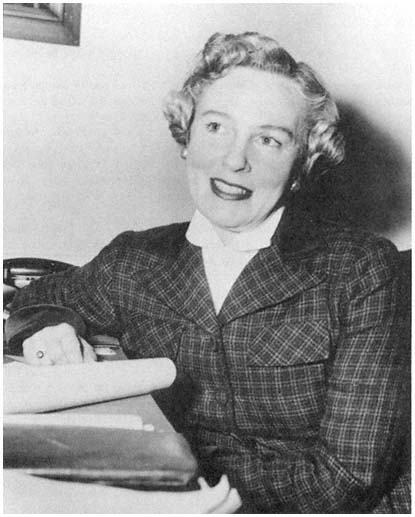








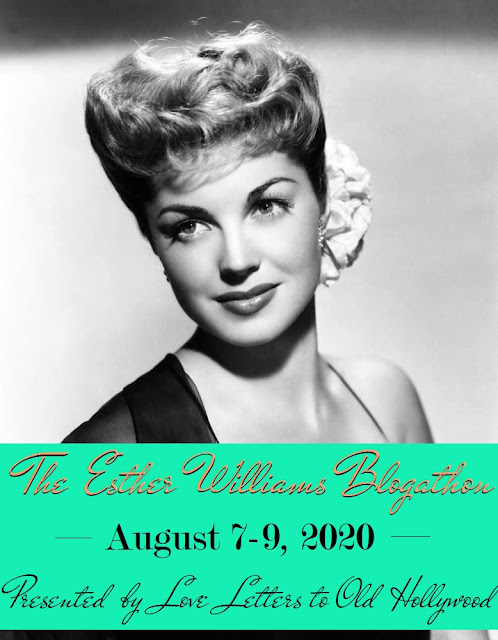


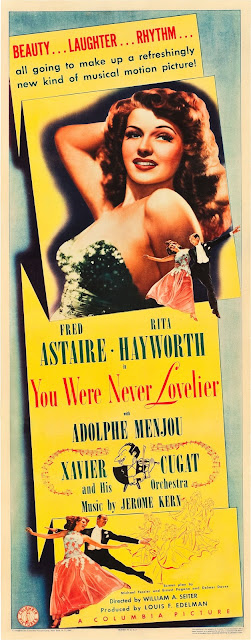


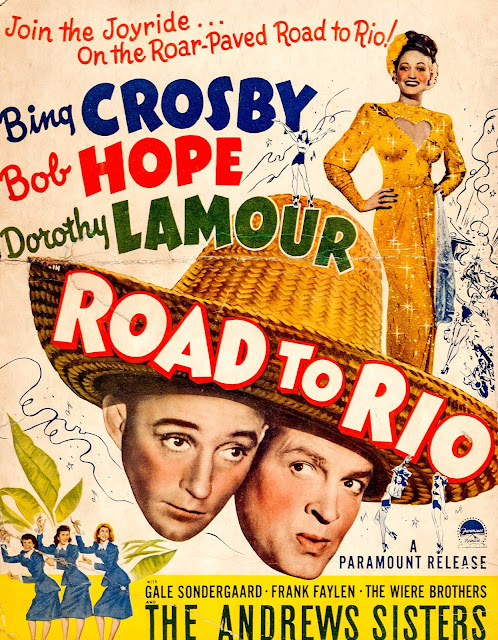



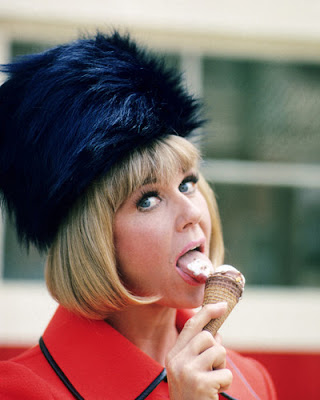
Congratulations Michaela ! What a wonderful Esther Williams blogathon this has been! So many wonderful tributes to Esther. This one with Dorothy Kingsley fascinating indeed! I just did a Wikipedia on Dorothy Kingsley what a collection of other wonderful movies Dorothy has written.
ReplyDeleteI'm sure had Esther received your letter she would have responded (which would have been magical for you). I saw an interview on TV a while back now, Esther mentioned that her fans meant a lot to her.
How special has this weekend been? Take care and thanks for wonderful memories.
Ros Down Under but upside down with delight thanks to you and the other contributors.
Thank you so much! I'm thrilled that this blogathon has been so much fun for you. I know it's been fun for me! I'm already excited to bring this back next year when it will be Esther's centenary.
DeleteIt was amazing to discover how many of my favorite movies were penned by Kingsley. And who knows how many more she doctored that we don't know about!
Thanks so much for letting us into the world of Kingsley and Williams.
ReplyDeleteI've never been able to understand the snobbish attitude toward pure entertainment. I never will.
Thank YOU for reading, Paddy!
DeleteI don't understand that attitude, either. It takes so much skill to craft something lighthearted that makes you feel good. And as Esther pointed out in her book, the money that her films earned made it possible for MGM to do the smaller dramas that probably wouldn't do as well at the box office.
Between this and your piece on the "ABCs of Esther Williams," if your goal was to be the end-all authority on all things Esther Williams, I think you can call that "mission accomplished" :)
ReplyDeleteThank you! I'll take "end-all authority" over "obsessive fan," which is probably the more accurate term. ;)
DeleteFascinating! I've heard of Kingsley but didn't know that much about her. Thanks so much for this. :-)
ReplyDeleteThanks for reading! There isn't a lot out there about Kingsley, unfortunately. The only real interview I could find of hers was in Patrick McGilligan's book Backstory 2.
DeleteI've watched many movies penned by Dorothy Kingsley, or for which she contributed, but never paiud attention to that screenplay credit. Even though she said she only wrote becasue she needed money, her name will forever be tied to the Golden Age of Hollywood. Very nice to read about her contributions with Esther.
ReplyDeleteKisses!
Le
Thanks, Lê! It sounds like Kingsley was quite modest about her work, but you're so right that she will always be a great part of old Hollywood. Like Charles Walters, she's one of those names who kind of faded into the background, but she deserves the spotlight!
Delete